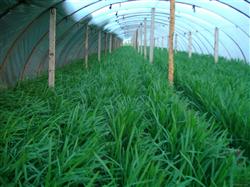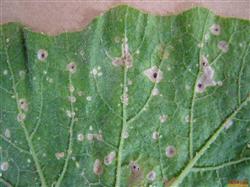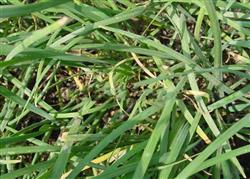Leek planting: how to grow leek in greenhouse in autumn and winter?

How to plant leek in greenhouse in autumn and winter? Please introduce the planting method of leek in greenhouse in autumn and winter. Planting leek in greenhouse in autumn and winter can refer to the following methods: 1. Select excellent varieties that can grow continuously without dormancy in winter. 2. The cultivation of strong roots is the basis of high yield and high benefit. The main measures are as follows: seedling transplanting and root-raising plants grow better, evenly and have higher yield than direct seeding. Sow seeds as early as possible after thawing in early spring, apply high-quality farm manure 5000kg to 8000kg per mu before sowing, cover soil and cover with plastic film to preserve soil moisture and increase temperature, promote early emergence of seedlings, and remove the film in time after seedling emergence. Three and four leaves of the seedlings were moved to the greenhouse plot. Generally, after the stubble of fruits and vegetables in the first stubble from June to July, the soil preparation is fully applied with organic fertilizer, ditching according to the row spacing of 30cm to 35cm, the width of the bottom of the ditch is 10cm, the spacing is 3cm to 4cm, each pinch is about 15 plants. Watering the seedlings after transplanting to keep the soil moist and watering in time after drying. The biggest difference between the technical measures of root cultivation of leek in autumn and winter and that of leek in dormancy greenhouse is that it can promote its rapid growth, accumulate more nutrients and cultivate sturdy roots. Therefore, there is no harvest in summer and autumn, and pay attention to ploughing and weeding, and pay attention to soil cultivation and drainage in rainy season. The Beginning of Autumn before the appropriate control of growth, to prevent lodging rot. After the Beginning of Autumn, strengthen the supply of water and fertilizer, promote growth, generally topdressing 2 to 3 times, per mu topdressing human feces and urine 2000 kg, or diammonium phosphate 50 kg, or ammonium sulfate 30 kg 40 kg plus calcium superphosphate 50 kg 100 kg. 3. The appropriate time for buckling film should be before the local initial frost. If the buckle grows early, the yield peak comes early, and it is easy to senescence; if the buckle suffers from cold injury in the open field, it is easy to cause leaf tip rot, and once the leek turns into passive dormancy, it grows slowly after buckling the film. 4. Management and harvesting after buckling film. Generally, you can make a shallow cut before buckling the film, and buckle the film immediately after harvest, so that it is easy to operate. If the leek has not reached the harvest standard, the film should be buckled first in order to prevent frost injury, but it must be operated carefully to prevent damage to the leek plant. In the initial stage of buckling film, the indoor temperature is higher, so it is necessary to strengthen ventilation to prevent excessive growth, and generally maintain no more than 25 ℃ during the day. With the decrease of external temperature, the air release volume was gradually reduced, keeping 20: 25 ℃ in the daytime and 5: 10 ℃ at night. After that, with the decrease of external temperature, the grass and paper quilts were covered at night, and covered early and uncovered late to strengthen the thermal insulation performance. After the production of leek buckle film in autumn and winter, it still needs to be fertilized and watered. Generally, when the plant height is about 10 centimeters, the ammonium sulfate is applied 40 kilograms per mu between the rows, and the ridges are watered. When the plant height is 20 centimeters, the ridges are cultivated again. Water 2-3 days before harvest. It is necessary to strengthen ventilation and dehumidification after each water, but pay attention to prevent frost damage. If the growth of leek is strong in autumn and winter, the harvest period can be extended from October to February-March of the following year. Attention should be paid to the shallowness of the knife for each harvest so as not to affect the growth of the next crop. But the last harvest, because cut off the leek root, can be cut as deep as possible. 5. strengthen the prevention and control of diseases and insect pests. Due to frequent watering in the greenhouse and high humidity, attention should be paid to the prevention and control of Botrytis cinerea: Sukeling smoke agent can be used to prevent it after each watering. Epidemic disease: the initial stage of the disease with 58% metalaxyl manganese zinc 500 times solution or 64% disinfectant alum 400 times solution spray control. Leek maggots can be eradicated with 1000 times of trichlorfon or phoxim. Click to get more leek planting techniques click to get more vegetable planting techniques
- Prev

Pumpkin planting: what to control pumpkin spot disease?
What to control pumpkin spot disease? What is pumpkin spot disease? Please introduce pumpkin spot disease is mainly harmful to leaves and rachis. The leaf spot is round to subcircular or irregular. The leaf margin is dark brown, the boundary of the healthy part is obvious, there are small black spots in the center of the disease spot, and when the leaf spot is serious, the leaf spot fuses, resulting in local death of the leaf. A flower axis.
- Next

Leek planting: why leek will be "dry tip"? How to prevent
Why do leeks "dry tip"? How to prevent it? Please introduce and guide the control method dry tip is a common physiological disease of leek, leek dry tip main factors have the following points: (1) harmful gas harm. Application of ammonium bicarbonate or undecomposed organic fertilizer will release a lot of harmful gases, if not timely ventilation...
Related
- Where is it suitable to grow horseradish in China? it is expected to see the middle altitude horseradish in Alishan.
- How to prevent tomato virus disease reasonably? (Control methods included)
- Many people like to plant towel gourd on the balcony. What are the main points of this method and management?
- What crops can chili peppers be mixed with?
- Fertilization techniques and matters needing attention in Tomato
- What are the grafting techniques for peach seedlings in spring?
- Harm and control methods of root swelling disease of Chinese cabbage
- What are the pests of sweet potatoes? How to prevent and cure it?
- Symptoms, causes and Control methods of navel Rot in Tomato
- The cause of "Cucumber rotten bibcock" in Farmers' planting Cucumber and its Control Plan

